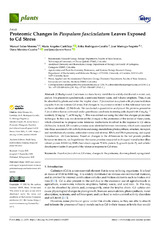Proteomic Changes in Paspalum fasciculatum Leaves Exposed to Cd Stress
Autor
Salas Moreno, Manuel
Castillejo-Sánchez, María A.
Rodríguez-Cavallo, Erika
Marrugo-Negrete, José
Méndez-Cuadro, Darío
Jorrín-Novo, Jesús V.
Editor
MDPIFecha
2022Materia
Paspalum fasciculatumCd stress
Changes in the proteome
Downregulated
Upregulated
METS:
Mostrar el registro METSPREMIS:
Mostrar el registro PREMISMetadatos
Mostrar el registro completo del ítemResumen
Background: Cadmium is a toxic heavy metal that is widely distributed in water, soil, and air. It is present in agrochemicals, wastewater, battery waste, and volcanic eruptions. Thus, it can be absorbed by plants and enter the trophic chain. P. fasciculatum is a plant with phytoremediation capacity that can tolerate Cd stress, but changes in its proteome related to this tolerance have not yet been identified. (2) Methods: We conducted a quantitative analysis of the proteins present in P. fasciculatum leaves cultivated under greenhouse conditions in mining soils doped with 0 mg kg−1 (control), 30 mg kg−1, or 50 mg kg−1. This was carried out using the label-free shotgun proteomics technique. In this way, we determined the changes in the proteomes of the leaves of these plants, which allowed us to propose some tolerance mechanisms involved in the response to Cd stress. (3) Results: In total, 329 variable proteins were identified between treatments, which were classified into those associated with carbohydrate and energy metabolism; photosynthesis; structure, transport, and metabolism of proteins; antioxidant stress and defense; RNA and DNA processing; and signal transduction. (4) Conclusions: Based on changes in the differences in the leaf protein profiles between treatments, we hypothesize that some proteins associated with signal transduction (Ras-related protein RABA1e), HSPs (heat shock cognate 70 kDa protein 2), growth (actin-7), and cellular development (actin-1) are part of the tolerance response to Cd stress.

